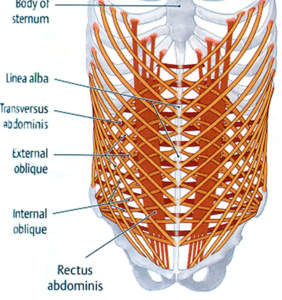 The abdominal muscles are the main bridge between the pelvis and the rib cage besides the lower spine. Our bones hold us up and our muscles move us. Ligaments connect bones to bones and tendons connect muscles to bones. Throughout most of the body there is a closely quartered network of bones along with muscle, ligament, tendons. Each supports the other in the alignment of the body .
The abdominal muscles are the main bridge between the pelvis and the rib cage besides the lower spine. Our bones hold us up and our muscles move us. Ligaments connect bones to bones and tendons connect muscles to bones. Throughout most of the body there is a closely quartered network of bones along with muscle, ligament, tendons. Each supports the other in the alignment of the body .
There is one section that fails to fall into this pattern. Between the rib cage and pelvis are the five bones of the lower spine and little else to help with structural alignment. There is a whole mess of muscle and fascia lending a hand to keep us upright but not much more.
The work of support falls to the abdominal muscles (along with the quadratus lumborum and multifidus and the erector spinea) of which there are four sets. The deepest is the transverse abdominis, a terribly important muscle when it comes to back pain. Then come the internal and external obliques, our twisting muscles. Finally there is the rectus abdominis, our sit ups muscles. These eight muscles (four on each side)are all intimately connected through tendon and fascia and need to all have equal tone to work effectively.
The tendency is for the rectus abdominis to be stronger—thereby diminishing the capacities of the other. This is a big problem for everyone but especially for people suffering from back, hip or groin pain. The rectus abdominis also carries one of the bodies interesting anomalies.
Most muscles make their way from bone to bone with a tendon on either end to facilitate connection. But because the rectus Abdominis covers too long a span—from the pubic bone to the base of the rib cage— for it to work effectively, it has tendons inserted between the series of muscles that all together make up on long muscle. These tendons provide support to this muscle that gets no help from a relationship to our bones.
If the upper and lower halves of the body are to work in concert, we must have tone and balance in the muscle groups between the pelvis and the ribcage. Because his area is the part of the body least supported by bone, the muscles need to carry a large supporting load.
